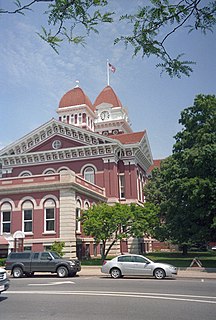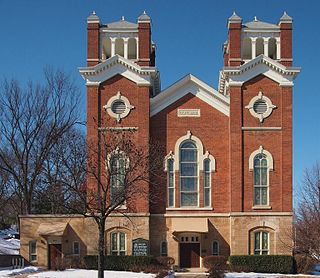
The Salem Downtown Historic District is a national historic district located at Salem, Washington County, Indiana. The original plat of the town, founded in 1814, is within the district. It is bounded by Mulberry and Hackberry Street in the north, Hayes Street in the east, the CSX railroad tracks in the south, and Brock Creek to the west. It encompasses 253 contributing buildings, 3 contributing structures, and 5 contributing objects in the central business district of Salem. The district was placed on the National Register of Historic Places in 1997. Its architectural styles are Italianate, Gothic Revival, Classical Revival, Late Victorian, Early Republic, and Late 19th/20th Century Revivals.

The Dubuque County Jail is a historic building at 36 East 8th Street in Dubuque, Iowa, United States. Completed in 1858, the jail is an example of the uncommon Egyptian Revival style. It is architecturally a highly original work of John F. Rague, who also designed the 1837 Old Capitol of Illinois and the 1840 Territorial Capitol of Iowa. The building was designated a National Historic Landmark for its architecture in 1987. It served as a jail for more than a century, became a museum in 1975, and was converted into county offices in 2016.

The Federal Street District is a residential and civic historic district in Salem, Massachusetts. It is an expansion of an earlier listing of the Essex County Court Buildings on the National Register of Historic Places in 1976. In addition to the former county court buildings included in the earlier listing, the district expansion in 1983 encompasses the entire block of Federal Street between Washington and North Streets. It includes buildings from 32 to 65 Federal Street, as well as the Tabernacle Church at 50 Washington Street.

Crown Point Courthouse Square Historic District is a historic district in Crown Point, Indiana, that dates back to 1873. It was listed on the National Register of Historic Places in 2004. Its boundaries were changed in 2005, and it was increased in 2007 to include a Moderne architecture building at 208 Main Street. The late nineteenth- and early twentieth-century commercial and public buildings represent a period of economic and political growth. The Lake County Courthouse stands in the center of the district. Designed by architect John C. Cochrane in 1878, this brick building is a combination of Romanesque Revival and Classical styles. Enlarged in 1909 with the addition of north and south wings, designed by Beers and Beers. Continued growth in the county required second enlargement in 1928. This local landmark was placed in the National Register of Historic Places in 1973.

The Genesee County Courthouse Historic District is located at the junction of Main, West Main and Ellicott streets in downtown Batavia, New York, United States. It is a small area with the county courthouse, a war memorial and other government buildings dating from the 1840s to the 1920s. Some were originally built for private purposes.

Dibley House, also known as Graf House, is a property in Fargo, North Dakota that was listed on the National Register of Historic Places in 1980. The listing included two contributing buildings on an area of less than 1 acre (0.40 ha). The listing included two contributing buildings on an area of less than 1 acre (0.40 ha).

Downtown Fargo District, or Downtown Fargo Historic District, is a historic district in Fargo, North Dakota that was listed on the National Register of Historic Places in 1983.
Fargo South Residential District is a 82.3-acre (33.3 ha) historic district in Fargo, North Dakota that was listed on the National Register of Historic Places in 1983.

Buechner & Orth was a St. Paul, Minnesota-based architectural firm that designed buildings in Minnesota and surrounding states, including 13 courthouses in North Dakota. It was the subject of a 1979 historic resources study.

Charles N. Daniels (1828-1892) was an American architect active in Minnesota, North Dakota, and Washington.

Edward Payson Bassford (1837–1912) was an architect who practiced in St. Paul, Minnesota, in the late 19th century. Born in Calais, Maine, on June 7, 1837, he moved to St. Paul in 1866. He worked in the office of Abraham Radcliffe for a time, then founded his own architectural firm. By the 1870s, Bassford was the busiest architect in St. Paul, working on designs for houses, schools, and many commercial buildings. His firm also employed architects who later were famous in their own right, such as Cass Gilbert, Augustus Gauger, Edward J. Donohue, Silas Jacobson, and Charles Bassford. He died in Osakis, Minnesota, on July 20, 1912.

Charles Emlen Bell (1858–1932), often known as C.E. Bell, was an American architect of Council Bluffs, Iowa and Minneapolis, Minnesota. He worked alone and in partnership with John H. Kent and Menno S. Detweiler. He also worked as part of Bell, Tyrie and Chapman. A number of his works are listed on the U.S. National Register of Historic Places.

The Sandusky County Jail and Sheriff's House is a historic government building near downtown Fremont, Ohio, United States. Built in the early 1890s, it was used as an incarceration facility for almost a century before closing and being converted into an office building.

The Pierce County Courthouse in Rugby, North Dakota was built in 1908. It was designed by St. Paul, Minnesota architects Buechner & Orth in Beaux Arts or Modified Renaissance style. It was listed on the National Register of Historic Places in 1980 as part of a multiple property submission for Buechner and Orth Courthouses in North Dakota.

The McLean County Courthouse in Washburn, North Dakota was built in 1908. It was a 2+1⁄2-story brick building with a central tower above the front entrance. It was listed on the National Register of Historic Places in 1985. The listing included two contributing buildings.

The Rockingham County Courthouse is a historic courthouse located at Wentworth, Rockingham County, North Carolina. It was designed by Frank P. Milburn and built in 1907. It is a Classical Revival style red brick building that consists of a three-story hipped roofed main block flanked by later added two-story flat roofed wings. It features a low and broad polygonal cupola atop the Spanish red tile roof. The 1907 courthouse, listed on the National Register of Historic Places in 1979, now houses the Museum and Archives of Rockingham County.
William J. Beardsley was a Poughkeepsie, New York-based architect.

The Chelsea Village Historic District encompasses the historic village center of Chelsea, Vermont, the shire town of Orange County. Developed in the first half of the 19th century as a regional service and transportation hub, the village exhibits a significant number of Greek Revival buildings, augmented with primarily later civic and commercial buildings. It was listed on the National Register of Historic Places in 1983.

The Butte County Courthouse and Historic Jail Building is a historic site in Belle Fourche, South Dakota. The buildings were placed on the National Register of Historic Places in 1998, with its significance being its association with the growth of local government in western plains communities, local figure Seth Bullock, and for making use of Classical architecture, representative of contemporary South Dakota public buildings.

The Brown County Courthouse is a historic courthouse in Aberdeen, the county seat of Brown County, South Dakota. It was built in 1904 and is listed on the National Register of Historic Places.






















